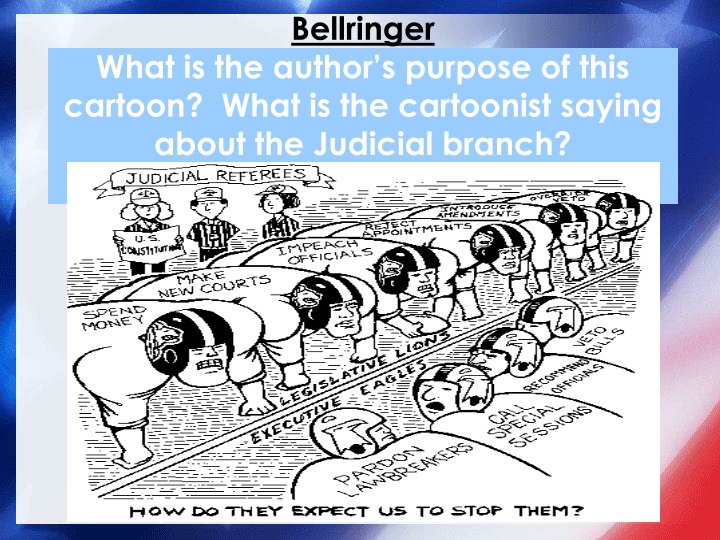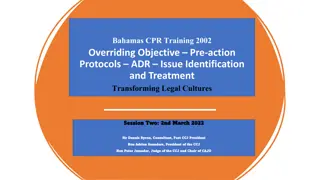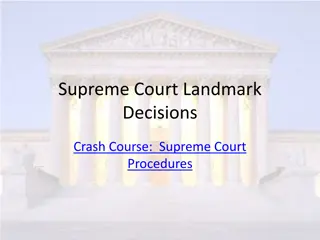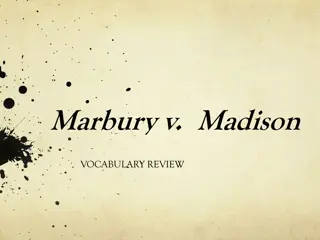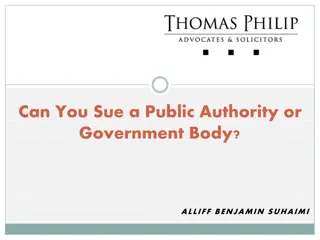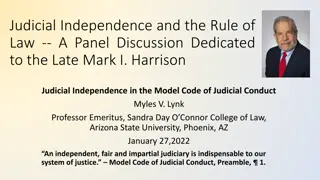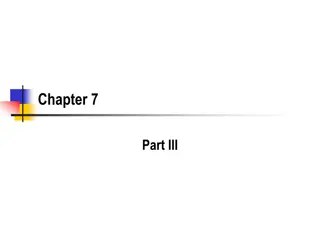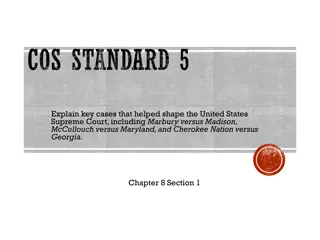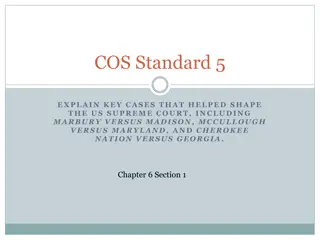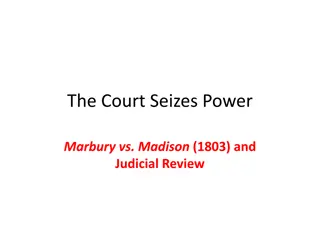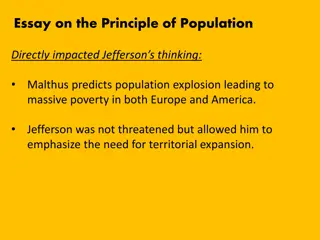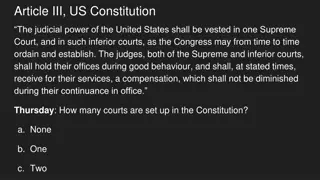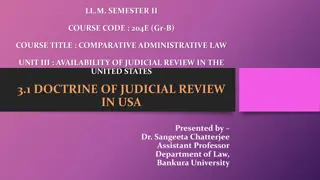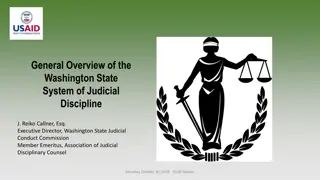The Marbury v. Madison Case: Judicial Review and Constitutional Power
The Marbury v. Madison case explores the power of judicial review in the United States. It delves into the conflict between President Thomas Jefferson and the Judicial branch over political appointments, leading to a landmark Supreme Court decision on the interpretation of the Constitution. John Marshall's role as Chief Justice and the implications of this case are highlighted in this historical narrative.
Download Presentation

Please find below an Image/Link to download the presentation.
The content on the website is provided AS IS for your information and personal use only. It may not be sold, licensed, or shared on other websites without obtaining consent from the author.If you encounter any issues during the download, it is possible that the publisher has removed the file from their server.
You are allowed to download the files provided on this website for personal or commercial use, subject to the condition that they are used lawfully. All files are the property of their respective owners.
The content on the website is provided AS IS for your information and personal use only. It may not be sold, licensed, or shared on other websites without obtaining consent from the author.
E N D
Presentation Transcript
Bellringer What is the author s purpose of this cartoon? What is the cartoonist saying about the Judicial branch?
Marbury v. Madison The power of Judicial Review
Meet our Cast of Characters John Marshall William Marbury John Adams Thomas Jefferson James Madison
How did it begin? President Thomas Jefferson (Republican) had just won the election of 1800. The outgoing President, John Adams (Federalist), appointed 58 members of his own political party to fill government jobs on his last night in office. It was the job of John Adams Secretary of State, John Marshall, to deliver the final paperwork to each newly appointed official. However, Marshall failed to deliver 17 of the appointments.
When Thomas Jefferson became President, he told his new Secretary of State, James Madison, not to deliver some of the remaining appointments. The new officials appointed by John Adams could not take office until they had their papers in hand. William Marbury was one of the officials waiting on his papers.
A face to the name John Marshall William Marbury John Adams Thomas Jefferson James Madison
The Battle Begins William Marbury decided to sue James Madison. He asked the Supreme Court to issue a court order requiring Madison to deliver his papers. Marbury argued that the Judicial Act of 1789 gave the Supreme Court original jurisdiction over this type of case. He claimed the Supreme Court had the authority to issue a writ of mandamus. The new Chief Justice of the Supreme Court had a big decision to make.
Court in Session Who was the new Chief Justice? None other than the man who failed to deliver the papers in the first place John Marshall. Was Marbury entitled to his job? If so, did the Judiciary Act of 1789 give the court the authority it needed to force Madison to deliver the papers?
Final Decision The Supreme Court ruled Yes, Marbury was entitled to the job. However, the court cannot force Madison to deliver the papers because the Judiciary Act of 1789, which granted the Supreme Court original jurisdiction over this type of case, was UNCONSTITUTIONAL.
Why Is This Important? This case established the Supreme Court s power of Judicial Review. The Supreme Court could now declare any act of the other branches unconstitutional.
DIRECTIONS Research Supreme Court cases listed on your chart. Remember to use reliable and credible websites. NO WIKIPEDIA!!! Using the chart, provide a summary, the significance of the case, and how it impacts your world or the world around you. You will also need to list your sources. A few examples of reliable websites: www.oyez.org/cases/ www.streetlaw.org/en/landmark/home www.pbs.org/wnet/supremecourt/timeline/index. html
RUBRIC Collaboration 5 Points Every team member is treated with respect. All members listen to all ideas. Each member is encouraged to participate. Sources 5 Points Sources used to find information are written on the back of the chart. Content 10 Points Content is accurate and written in complete sentences. Details and support are used in summary and significance. Content fully explains the impact of each case.
Exit Slip Of the landmark cases you ve researched so far (including Marbury v. Madison), which do you feel has had the biggest effect on today s society? Use information from the activity to support your answer.
Bellringer: Analyze the authors purpose.
Videos Review Judicial Branch
Classwork Answer questions 7-10 on page 282. 7 & 8 are multiple choice 9 & 10 should be answered as short responses.
